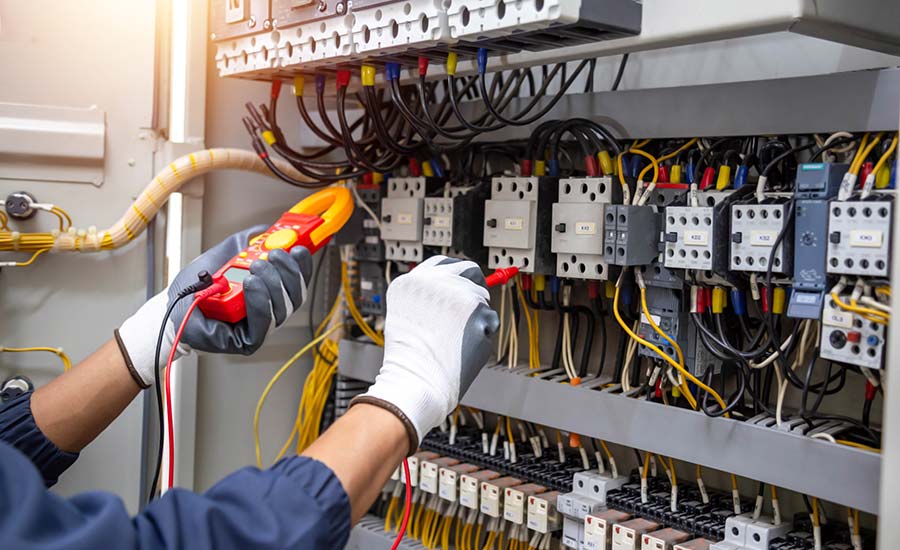
Electrical circuits form the foundation of modern technology, powering everything from simple household devices to complex industrial machinery. By grasping the fundamentals of electrical circuits, you can better appreciate how these systems work, troubleshoot issues, and innovate in various fields.
We will start by exploring the basic types of circuits, such as series and parallel circuits, and the distinctions between open and closed circuits.
Types of Electrical Circuits
Electrical circuits are categorized based on how their components are connected and how current flows through them.
The key types of electrical circuits include:
Open Circuit
An open circuit is a type of electrical circuit where the path for current flow is incomplete. This interruption means that electricity cannot flow through the circuit.
Common causes include a switch being in the ‘off’ position or a break in the conductor. Open circuits are essentially non-functional until the gap is closed, completing the path for current flow.
Closed Circuit
A closed circuit has a complete path, allowing current to flow uninterrupted from the power source, through the components, and back to the source.
This type of circuit is operational, with all connections intact and switches closed. Everyday examples include a light bulb turning on when its switch is flipped to the ‘on’ position.
Short Circuit
A short circuit happens when a low-resistance connection forms between two points in an electrical circuit, bypassing the intended path of current flow.
This can cause excessive current to flow through the circuit, potentially leading to overheating, component damage, or even fires. Short circuits are often the result of faulty wiring, component failures, or accidental connections.
Series Circuit
In a series circuit, components are connected end-to-end in a single path for the current to flow. This means that the same current flows through all components sequentially.
However, if one component fails or is disconnected, the entire circuit stops working. Series circuits are commonly used in applications where components need to operate in a specific sequence, such as certain types of Christmas lights.
Parallel Circuit
Parallel circuits have multiple paths for the current to flow, with each component connected across common points. This configuration allows each component to operate independently; if one component fails, the others can still function.
Parallel circuits are widely used in household electrical wiring, where each outlet and light operate independently of the others.
Series-Parallel Circuit
A series-parallel circuit combines elements of both series and parallel circuits. Some components are connected in series, while others are connected in parallel within the same circuit.
This hybrid configuration can optimize performance and provide greater flexibility for various applications, balancing the benefits of both circuit types.
AC Circuit
An AC (alternating current) circuit is one where the current periodically reverses direction. AC circuits are the standard for power distribution systems because they can efficiently transmit electricity over long distances.
The use of transformers in AC circuits allows for the easy conversion of voltage levels, which is crucial for the grid system supplying power to homes and industries.
DC Circuit
A DC (direct current) circuit has current flowing in one direction only, typically from a battery or a DC power supply.
DC circuits are commonly found in electronic devices, such as smartphones, laptops, and other portable gadgets. The stable voltage of DC circuits makes them ideal for applications requiring precise and consistent power delivery.

Key Components of Electrical Circuits
Electrical circuits are made up of various components, each serving a specific function that contributes to the overall operation of the system.
The most common components found in electrical circuits include:
Resistors
Resistors are fundamental components that oppose the flow of electric current, thereby controlling the amount of current that flows through a circuit. They are used to limit current, divide voltages, and protect other components from excessive current.
Resistors are characterized by their resistance value, measured in ohms (Ω). They come in various forms, including fixed resistors, variable resistors (potentiometers), and special types like thermistors and varistors.
Capacitors
Capacitors store and release electrical energy in a circuit. They are used to smooth out fluctuations in voltage, filter signals, and in timing applications. A capacitor consists of two conductive plates separated by an insulating material called a dielectric.
When connected to a power source, capacitors store energy in the electric field between their plates. The capacitance value, measured in farads (F), determines how much charge a capacitor can store.
Inductors
Inductors, also known as coils or reactors, are components that store energy in a magnetic field when electric current flows through them.
They are used in filtering, tuning circuits, and in applications requiring energy storage. Inductors oppose changes in current flow, which makes them useful for smoothing out AC signals in power supplies and for creating inductive kickback in various circuits.
The inductance value, measured in henrys (H), indicates the inductor’s ability to store magnetic energy.
Diodes
Diodes are semiconductor devices that allow current to flow in one direction only, acting as a one-way valve for electric current.
They are used in rectification (converting AC to DC), signal demodulation, and voltage regulation. The most common type is the silicon diode, but there are also special-purpose diodes like light-emitting diodes (LEDs) and Zener diodes, which are used for voltage regulation and protection.
Transistors
Transistors are semiconductor devices that can act as amplifiers or switches. They are fundamental building blocks in modern electronics, used in virtually every electronic device. Transistors come in two main types: bipolar junction transistors (BJTs) and field-effect transistors (FETs).
They control the flow of current between two of their terminals (collector and emitter for BJTs, source and drain for FETs) based on the voltage applied to the third terminal (base for BJTs, gate for FETs).
Applications of Electrical Circuits in Different Industries
Electrical circuits are the backbone of modern technology, playing a crucial role in a wide range of industries. Understanding how these circuits are applied can help you appreciate their importance and potential.
Here, we explore some key industries where electrical circuits are indispensable.
Automotive Industry
In the automotive industry, electrical circuits are integral to the operation and efficiency of vehicles. Modern cars are equipped with numerous electronic systems that enhance performance, safety, and comfort.
From the engine control unit (ECU) that manages engine functions to advanced infotainment systems, electrical circuits are everywhere. They control lighting, power windows, airbags, and navigation systems, ensuring that vehicles are not only functional but also safe and enjoyable to drive.
Telecommunications
Telecommunications relies heavily on electrical circuits to transmit voice, data, and video over long distances. Circuits in this industry are designed to handle high-frequency signals and large amounts of data.
They are used in devices such as smartphones, routers, and satellites. Communication networks, including the internet, depend on complex circuit designs to maintain fast and reliable connections. These circuits manage signal processing, data encoding, and error correction, enabling seamless global communication.
Consumer Electronics
Electrical circuits are at the heart of consumer electronics, powering devices like smartphones, laptops, televisions, and home appliances. These circuits allow for the miniaturization of components, making devices more compact and efficient.
In consumer electronics, circuits are responsible for processing data, managing power, and interfacing with users. For instance, the circuits in a smartphone enable it to perform many functions, from making calls and browsing the internet to running applications and taking high-quality photos.
Industrial Automation
In industrial settings, electrical circuits are used to control machinery and processes, enhancing efficiency and precision. Programmable logic controllers (PLCs) and automated systems rely on these circuits to perform tasks such as monitoring sensors, controlling motors, and managing production lines.
By using electrical circuits to automate repetitive and complex tasks, industries can achieve higher productivity and consistency in their operations.
Healthcare
The healthcare industry benefits significantly from the application of electrical circuits in medical devices and equipment. These circuits are crucial in diagnostic tools like MRI and CT scanners, which provide detailed images of the human body.
They are also used in life-saving devices such as pacemakers, defibrillators, and monitoring systems. Electrical circuits in healthcare equipment must be highly reliable and precise, as they directly impact patient care and treatment outcomes.

Understanding Series and Parallel Circuits
When working with electrical circuits, you will frequently encounter series and parallel configurations. Each has distinct characteristics that affect how the circuit operates and performs.
Series Circuits
In a series circuit, all components are connected end-to-end in a single path for the current to flow. This means that the same current passes through each component sequentially.
If one component fails, the entire circuit is broken, and the current stops flowing. Series circuits are simple to design and are commonly used in applications where the operation depends on a specific sequence, such as in some types of Christmas lights.
Parallel Circuits
Parallel circuits, on the other hand, have multiple paths for the current to flow. Each component is connected across common points, providing separate pathways for the current. If one component fails, the others can continue to operate.
This configuration is ideal for applications requiring reliable and independent operation of multiple components, such as in household wiring systems where each light or appliance can function independently.
Key Differences
- Current Flow: In series circuits, current is the same through all components. In parallel circuits, current can vary across different branches.
- Voltage Distribution: In series circuits, the voltage is divided among components, whereas in parallel circuits, each component receives the full voltage of the power source.
- Reliability: Series circuits are less reliable since one failure affects the entire circuit. Parallel circuits offer higher reliability, as each branch operates independently.
AGS Devices: A Trusted Distributor of Passive and Active Components
AGS Devices specializes in the distribution of high-quality electronic components that are important for electrical circuits, ensuring each product meets stringent standards.
Our comprehensive quality control system ensures authenticity and high-performance standards required in various applications.
We also distribute electronic components such as:
- Power Supply Distributors
- Semiconductors for Sale
- Optoelectronics
- Circuit Protection
- Interconnects
- Passive Components Electronics
- Electronic Testing Equipment
- Electromechanical Devices
We are dedicated to supplying all types of electronic components that are reliable and durable.
At AGS, we understand the crucial role these components play in electronic circuits. We have established rigorous procedures to ensure that every component we distribute enhances the performance and reliability of your projects.
As a leading distributor of capacitors, our goal is to boost the efficiency and reliability of your supply chain.
